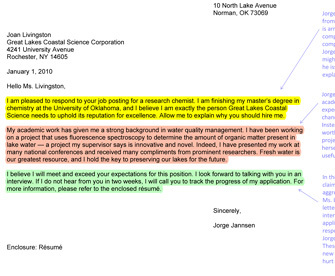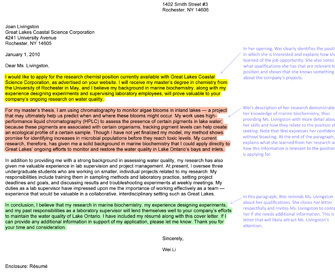« Prev Next »

Formal Letters
Writing a job letter
Formal letters differ in some key ways from e-mail and even from professional memos. The purpose of a formal letter is often serious: It may be a formal application for a job, a formal statement of a job offer (containing legally binding language and contract details), a formal thank-you note following an interview, a formal document from your employer offering a promotion, or even a formal performance review that will go into your permanent employee file. These matters are generally too important to handle in an informal medium like e-mail or a memo. In addition, recipients may want a document that can be signed and filed in a traditional way.
Job letters and cover letters — or the letters you write to an organization to apply for a job — are an excellent example of formal correspondence. If you seek a competitive position in your field, you will likely need to write this type of document, which expresses your interest in a particular job and showcases your qualifications. To write a strong cover letter, you must first understand your audience. Find out as much as you can about the company, university, or research organization beforehand, then tailor your letter to suit that audience — in tone, content, and emphasis. Resources for information about companies and university research groups include corporate or university Web sites, patent databases, journal databases, newspapers and trade journals, or colleagues in your professional organizations.
Structuring a job letter
If you are writing a job letter for an entry-level position, consider keeping the length of your letter around two-thirds to three-quarters of a page. The structure of a letter written for an entry-level position will differ from the structure of a letter written by a master's or Ph.D.-level researcher. Typically, a more advanced position will require a lengthier cover letter. In all cases, however, remember that your readers are extremely busy. Therefore, keep your letters from extending beyond two pages, unless the job advertisement specifically requests more details about research or work experience.
Most standard job letters consist of three main sections — an opening, a middle, and a closing.
- Opening: In the opening, introduce yourself and your purpose for writing. Identify the position you are seeking by name and state how you learned of the position. Establish that you have at least the minimum requirements for the job by listing your specific academic degree and any immediately relevant work experience.
- Middle: In the middle part of the letter, emphasize how your skills directly relate to the responsibilities listed in the job advertisement. One way to do this is by expanding upon one or two of the most interesting, relevant, or impressive items on your résumé. Also, if you have unique work or internship experiences or if you have taken specialized courses that are directly relevant to the needs listed in the job ad, describe them here. Such details make your letter memorable.
- Closing: As you close your letter, invite the reader to view the attached résumé. Express your willingness to provide more information. State that you are available for an interview and thank the reader for taking time to review your application. Do not use your closing to impose a deadline for a response, however: Deadlines seem pushy and may have a negative effect on your tone. Recruiters will respond to you on their own schedule.
Crafting your tone
In your cover letter, use first person ("I"), and refer to the person or people you are addressing as "you" or "your company." Think of specific details you can share so that the letter is memorable and, when providing those details, remember to sound confident (but not arrogant) and respectful (but not passive or subservient). Use active voice when describing your qualifications — you will sound more energetic and more direct. Finally, be clear and concise. Recruiters often read cover letters quickly, so get to the point early in your letter.
The first cover letter to the right demonstrates how poor tone can give an employer a bad impression. Note in particular the boastful tone that the writer uses and the demands he makes of the reader at the end of the letter.
In the second letter to the right, Wei Li applies for the same position. In contrast to Jorge's letter, this example provides rich details that are well tailored to the needs of the position, and it conveys this information using a respectful, confident tone. Wei's letter is a strong model of an appropriate cover letter.

Within this Subject (22)























